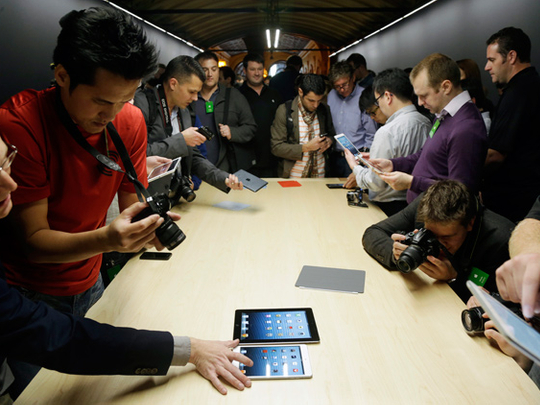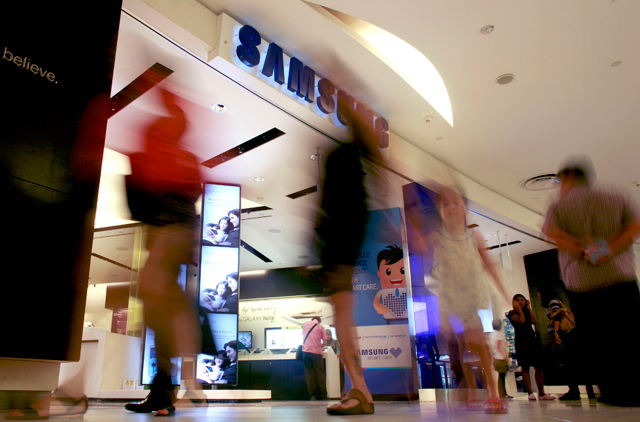
The technology sector has been short on breakthroughs but high on applying tech, defending market territory and shifting competitive landscape throughout 2012. Looking back at the sector, one could call it the year of living competitvely, or socially, or portably.
Apple got busy suing Samsung (with some success in the US) and Nokia resolved its litigation against Blackberry’s RIM through an agreement to cooperate together to reclaim lost ground from market leaders, namely Apple, Samsung and Google. The war raged on in OS universe, seeing Apple’s ‘Walled Garden’ dogma lose vast territory to open source Android. And Google, which bought Android in 2005, can thank Samsung for the spectacular success of its Galaxy product line-up.
Add Facebook’s fiasco with its IPO, which many expected to become history’s biggest, and the year turns to one of, well, living disappointedly. Facebook expected its IPO to detonate a mushroom cloud but instead it turned out to be a dud, with investors questioning the social networking business fundamentals, especially as the social media leader had been stingy with market numbers. Facebook has also failed to trigger mass interaction with its advertising model; in spite of the fact that it commands over a billion users today.
In the second half of this month, however, FB’s share price started to climb up again after it had slid to below half its IPO launch price of about $40.
Then there is Microsoft, which heralded its Windows 8 operating system on October 26, modifying their OS to operate on all platforms: computers, smartphones and tablets. This month also saw the Redmond-based company launch their first tablet, calling it Surface.
So, what else has happened during those 12 months of tech?
Post Steve-Jobs Apple has seen its market dominance pass over to Android as many pundits have been expecting. Apple has also rolled out its fourth generation iPad4 in March; and in October it introduced the iPad Mini; thus copying (for a change) Samsung’s “phablet” the Galaxy Note 2, which is a cross-breed fusing the phone with a tablet. The Cupertino-based company also launched iPhone 5 in September with the iOS-6 operating system, which offered “the most powerful, beautiful mapping service ever,” as the Apple promise went. But it was anything but that and users were soon voicing deep disappointment with messed up street naming and muddled map shapes. Apple had to retreat back into google’s laps, a humiliating defeat and the new CEO Tim Cook went public with apologies to consumers and yes, “we screwed up,” he later admitted. This was the year of “Retina” displays for Apple and the all-new 21.5” iMac, launched in November.
Google also couldn’t watch the hardware market go by without doing its own gig. After all, the company is awashed with capital and that produced the $199 Nexus 7 tablet, which Asus made for Google and which went on to register good sales.
It was last year also that the rivalry between Samsung and Apple would simmer to a boiling point, which led to litigation in international markets. Apple had only managed a big win against Samsung on its home turf but in South Korea, Japan and the UK, its infringement claims were not honoured. Indeed, Samsung has managed to pit its product against the old market leaders. This month it was announced that the South Korean manufacturer has finally ousted Nokia from the top rank of being the biggest shipper of mobile phones worldwide. Nokia held this top position for 14 years in a row. Indeed, 2012 has been a stellar year for Samsung and their product was hailed as the most recognisable smartphone brand in the world, with Galaxy S3 and Galaxy Note 2 obviously the catalysts of that.
“The big gain this year came with the Galaxy S3 and Note 2, which led the way in Samsung’s share of dominance for this segment. Samsung also had a whole host of low- and mid-end phones that helped them firm up the market. The success of Samsung has also been the success of Android as a platform in the UAE as it gained mass acceptance only because of the success of these two Samsung devices,” said Ashish Panjabi, Chief Operating Officer, Jacky’s Group of Companies.
In the business of web markets, which moves at light speed, a little insecurity could mean a big break to tiny brands, which explains why Facebook would pay Instagram $715.3 million to acquire its software and user base.
In good old television universe, “smart TV” is the deal. The new TVs have become infected with the social and interactive bugs. They’ve gotten smarter and more willing to interact with users, recognising voices and responding to hand gestures while allowing users to surf the web, as well as record whatever one missed in normal TV programmes.
According to Luo Hui-lung, researcher at Digitimes, smart TVs have a huge growth potential and accounts for 37 per cent of all televisions this year. “Smart TVs are the next big thing in technology after 3D TV had been introduced; but obstacles remain and they need to be addressed by vendors,” he said.
The resolution delivered on screens or picture quality has also jumped by leaps and bounds. LG and Sony launched the Ultra High Definition TV (UHDTV) or 4K and 8K TV formats. The first brings a resolution of 3840 × 2160 (8.3 megapixels), which offers twice the horizontal and vertical resolution of the 1080 pixel HDTV format and four times as many pixels. The 8K TV resolution quality has also been done but the price tag is beyond the reach of you and your neighbors, as a pop is estimated to sell for a million dollars.
In the internet arena, hacktivist group Anonymous spent much of the year fuming and bringing down websites of organisations they deemed to be bulldozing internet freedoms. It was in July that the world would face new malwares, the Madi, Duqu, Flame and Thunderstruck, which were targeting critical infrastructure. This was about the same time that the Atomic Energy Organisation of Iran was under attack. Then the Shamoon malware hit Saudi Aramco’s 30,000 workstations in August.
What 2013 hides is anyone’s guess; but to keep a safe projection, one might hope that 4G or Long Term Evolution (LTE) networks are offered with cheaper rates for users while expanding to wider global coverage. This would truly make mobile computing a breeze.











